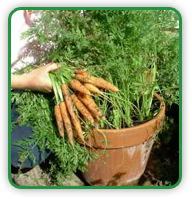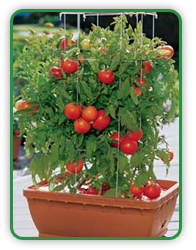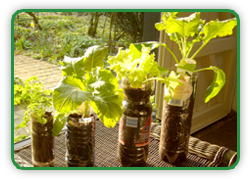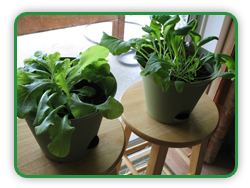|
Home > Guides > Urban Gardening > Container Gardening > Container Vegetable Gardening Guide |
|
Container Vegetable Gardening Guide |
Container  Mini Gardens Mini Gardens  Micro Gardens Micro Gardens |
For obvious reasons, most crops have been traditionally cultivated in open spaces such as gardens and fields. These environments offer ample sunlight and an abundance of space for plants to grow. Growing vegetables or herbs in Container Gardens (also known as Mini or Micro Gardens), on the other hand, requires resourcefulness and careful planning to produce sizable yields for survival. Fortunately this approach affords the attentive gardener greater flexibility and control over the growing medium. With these tools, a healthy and abundant harvest can be secured even in the most challenging locations.
|
 |
|
|
| |
|
|
| |
|
|
| |
Container Gardening
Types of Containers
 A wide variety of containers can be used to cultivate container gardens, including raised beds, window boxes, ceramic pots, old claw-foot bathtubs, and whatever else is easily available. Anything that has housed potentially harmful substances, such as old paint cans, should be avoided. Containers with open bottoms or holes in the bottom will allow for good drainage, but are not necessarily ideal as nutrients and minerals leached from the soil will drain out as well. If using a container with a sealed bottom, it is recommended to line the bottom with stones or something similar to allow for drainage and prevent the bottom of your container from becoming excessively A wide variety of containers can be used to cultivate container gardens, including raised beds, window boxes, ceramic pots, old claw-foot bathtubs, and whatever else is easily available. Anything that has housed potentially harmful substances, such as old paint cans, should be avoided. Containers with open bottoms or holes in the bottom will allow for good drainage, but are not necessarily ideal as nutrients and minerals leached from the soil will drain out as well. If using a container with a sealed bottom, it is recommended to line the bottom with stones or something similar to allow for drainage and prevent the bottom of your container from becoming excessively  moist. moist.
Special Considerations for the Indoor Container Grower
Container gardening can be very productive for city dwellers or others with limited space or topsoil. Growing such gardens indoors is especially attractive to such people as these environments offer greater year-round stability of heat and humidity. Crops that require less time to grow, such as greens and microgreens, make the best choices for indoor cultivation. Other options to improve light conditions, including using shelves, supplementing with artificial lighting, moving container gardens to maximize light exposure, using reflectors, and constructing makeshift greenhouses can all be utilized to offset the potential challenges to indoor container gardening.
|
| |
|
|
|
| |
|
|
|
|
Growing Vegetables in Containers
 A wide array of vegetables can be grown in containers in windows, on patios and balconies, or any location that receives consistent sunlight. Greens such as lettuce, arugula, spinach and others make an ideal choice because of the relatively short time to harvest, shallow root structures, and repeated collections that can be made during the growing season. Nearly any vegetable can be grown in a container, if adequate soil depth is provided. Root vegetables, beans, and other types may require 18" or more for proper root growth. A wide array of vegetables can be grown in containers in windows, on patios and balconies, or any location that receives consistent sunlight. Greens such as lettuce, arugula, spinach and others make an ideal choice because of the relatively short time to harvest, shallow root structures, and repeated collections that can be made during the growing season. Nearly any vegetable can be grown in a container, if adequate soil depth is provided. Root vegetables, beans, and other types may require 18" or more for proper root growth.
Other Considerations
 Soil composition becomes especially important in container gardens as there is a limited space that your plants utilize for moisture and nutrition. An ideal medium for most vegetables should be lightweight, well-drained, and rich in organic matter. Moisture retention is especially important to container gardens. Mulching and self-watering containers can help ensure to protect moisture and maintain a steady supply of water. Such containers deliver water to the roots, promoting a strong base that will promote healthy, stable plants. Additionally, properly maintained self-watering containers can typically go several days between waterings, and saving time and adding convenience. Soil composition becomes especially important in container gardens as there is a limited space that your plants utilize for moisture and nutrition. An ideal medium for most vegetables should be lightweight, well-drained, and rich in organic matter. Moisture retention is especially important to container gardens. Mulching and self-watering containers can help ensure to protect moisture and maintain a steady supply of water. Such containers deliver water to the roots, promoting a strong base that will promote healthy, stable plants. Additionally, properly maintained self-watering containers can typically go several days between waterings, and saving time and adding convenience.
|
|